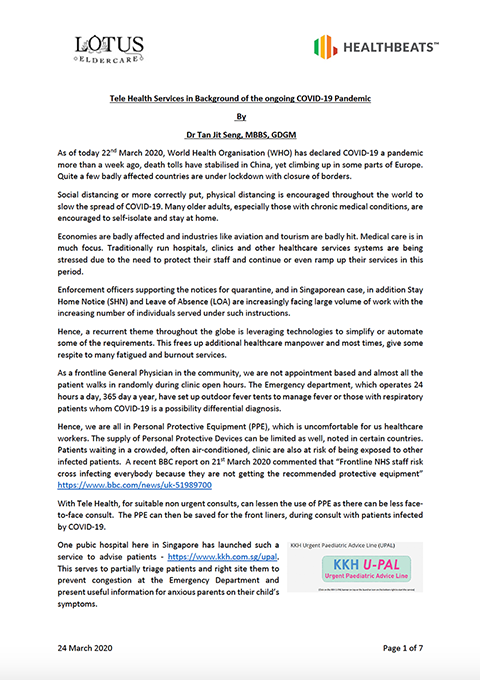Dr Tan Jit Seng is a practicing Long-term Home Care Physician leveraging on the use of technology to support his patients since 2009 in Singapore. He was part of the hospital staffing during the 2003 SARS Epidemic, running Nursing Care Facilities during the 2009 H1N1 Pandemic and now in community care service including frontline GP clinic and home care services during this 2019 COVID-19 Pandemic. In this paper, he examines the practical use of various technologies to support clinicians during this COVID-19 pandemic.
Excerpt from paper as follows:
With the advent of smart phones, high speed internet or 4G connectivity, many healthcare devices are now bluetooth enabled and able to connect to an accompanying phone application for seamless recording and transmission. One such example is HealthBeats® global platform (www.healthbeats.co). HealthBeats® provides simple-to-use remote vitals monitoring to both clinicians and patients for ease of adoption. Tele vital signs monitoring can be of much use to continue to monitor patient off site, when the care institution is overloaded or when monitoring of well individuals are needed to watch out for clinical deterioration
Tele vital signs monitoring can include the following but not exclusively:
1. Blood Pressure monitoring
2. Heart Rate and Rhythm monitoring (point or continuous)
3. Oxygen Saturation monitoring
4. Temperature monitoring
5. Blood Capillary Glucose monitoring
6. Weight monitoring
We know that COVID-19 is an RNA virus affecting the respiratory tract in human. Common clinical symptoms are fever and cough, and in more severe cases, shortness of breath leading to respiratory failure needing ventilation. Many are under quarantine, some precautionary and some have the active disease which are mild and not requiring very much medical support apart from medications. Due to limitations in hospital and healthcare institution capacity, not all actively infected cases are held quarantine and managed in tertiary hospitals. In fact, most of them might never need to be hospitalised. However, they should be monitored remotely for possible deterioration, and personal devices like tele monitoring equipment will be very handy.
For those well and on precautionary quarantine or stay home notices, with such systemised digital collection of temperature data, Officers in charge of such proceedings can have one less issue to worry. For those who might be diagnosed with COVID-19 infection and are in quarantine, such personalised use of equipment can reduce the strain on Healthcare workers and can be remotely administered. The use of pulse oximetry can also be very useful, since mild post exertion desaturations can be a guide to worsening of the infection. Support can be given earlier as pulse oximetry can be a form of triage for more invasive services, especially in Older individuals with chronic diseases.
Apart for the practical usage of Tele Vital signs monitoring in the fight of COVID-19 War, it can also be used to reduce the strain on healthcare systems from its “Business as Usual” or BAU load. Healthcare systems are usually already quite loaded during “peacetime”, and with the ongoing COVID-19 Pandemic, many institutions are seeking to reduce their BAU load to better focus on the infection cases. Most non-essential reviews, like updating their prescriptions for chronic diseases can be done remotely, which such Tele Vital signs services crucial in reassuring both the physician and patient that they remained well. Thus, review appointments dates can be much postponed and the physician can monitor patient with an ease of mind.
In the Singaporean System, 80% of chronic care loads are placed on public care facilities known as Polyclinics. Here, patients are seen for their chronic disease such as hypertension, diabetes mellitus, dyslipidemia, asthma, thyroid conditions and many others. Polyclinics provide subsidised care for Singaporean Citizens and are usually jammed packed daily. Most of the revisiting patients have well controlled chronic conditions thanks to the well-trained physicians and nurses. Tele Health and Tele vital sign monitoring can significantly reduce the bulk of healthcare resources, saving up PPEs and monitoring more closely the chronic conditions remotely.
Hospitalised patient for non-COVID issues can also be discharged earlier with continued monitoring at home from the hospital to reduce the load. Patient care can be passed onto a separate team doing community-based case and revert to the hospital for advices and consultations when needed. Reducing BAU pressure on healthcare system using Tele Vital Sign monitoring is another element which technology can be utilised. The cost of such devices and platforms has nosedived in recent years and it will be common practice in future to empower both the patients and individuals requiring monitoring.

For more information, please click here.
